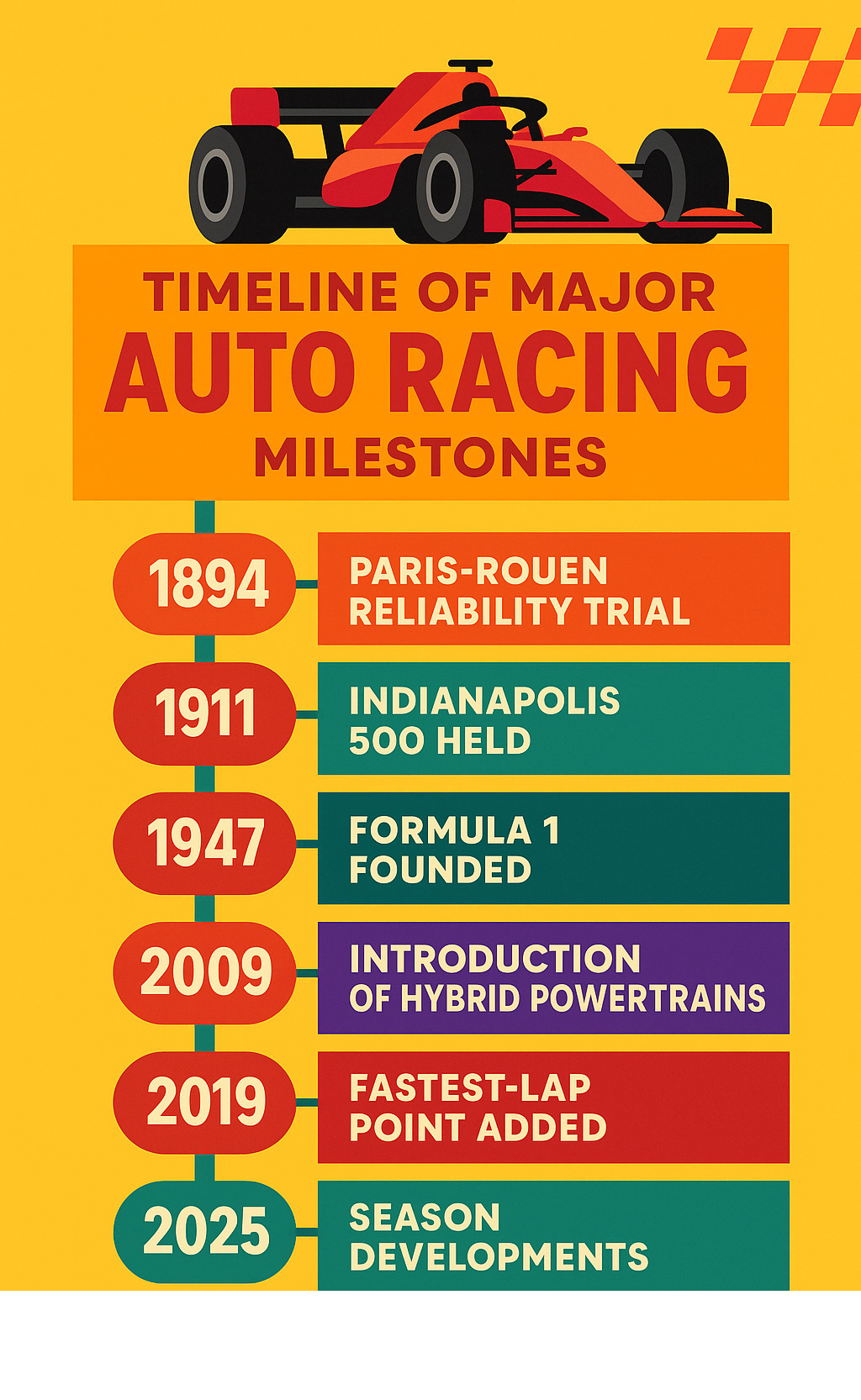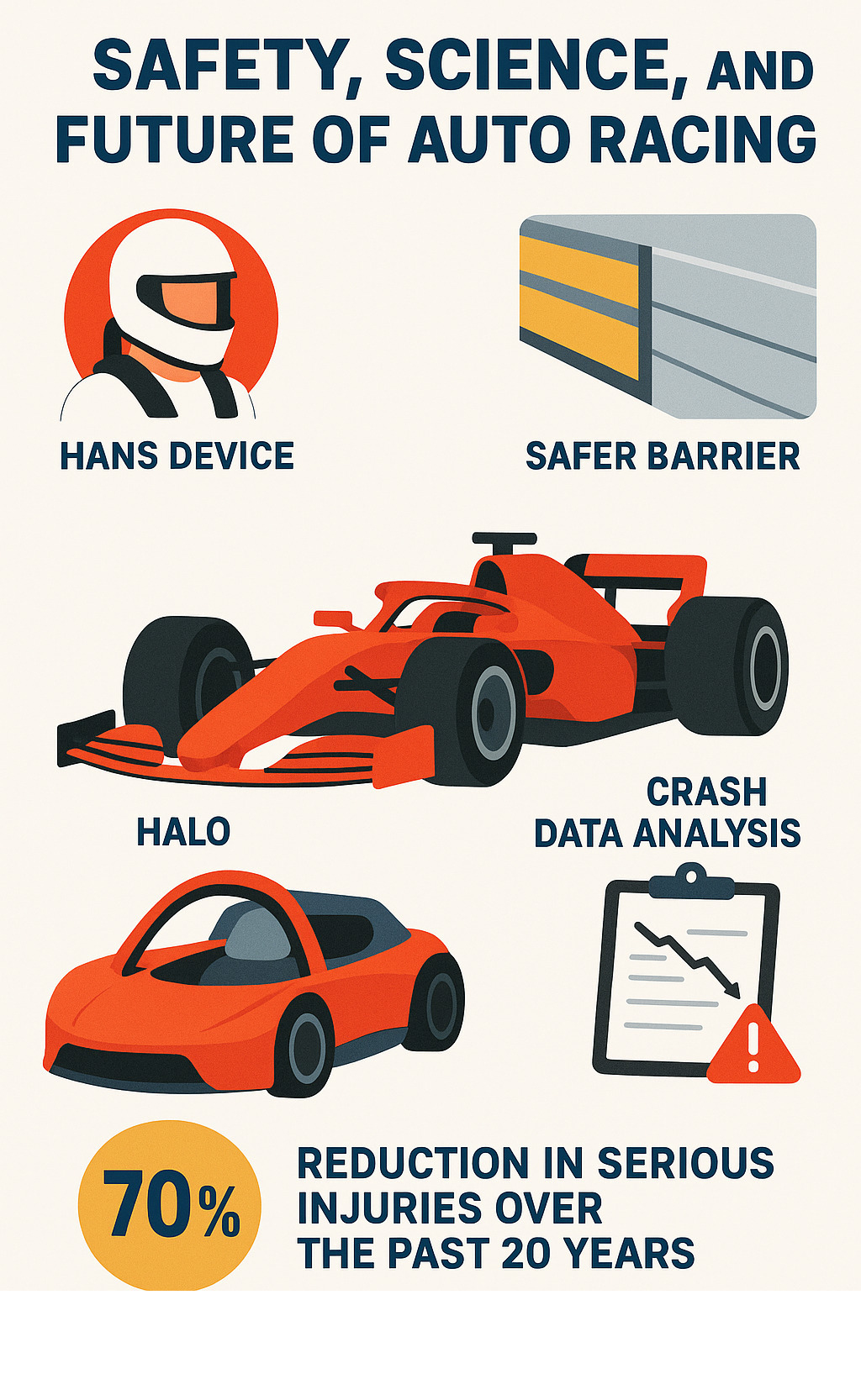Auto Racing: 10 Powerful Reasons to Love It in 2025
Why Auto Racing Captivates Millions of Fans Worldwide
Auto racing is a motorsport where drivers compete in specially designed cars at high speeds on various tracks, from oval speedways to winding road courses. This thrilling sport combines cutting-edge technology, split-second decision making, and incredible driver skill to create one of the world’s most exciting spectacles.
What is Auto Racing?
- Competition format: Drivers race automobiles for position and fastest times
- Main categories: Formula 1, NASCAR, IndyCar, sports car racing, drag racing
- Key elements: Speed, strategy, technology, and driver skill
- Global reach: Millions of fans across every continent
The sport traces back to 1894 when the first organized auto contest ran from Paris to Rouen – a 50-mile reliability trial that averaged just 10 mph. Today’s races feature cars hitting speeds over 230 mph, with Formula 1 cars carrying over 300 sensors monitoring everything from tire temperature to driver heart rate.
Auto racing offers something for every fan. Love pure speed? Drag racing delivers 300+ mph runs in under four seconds. Prefer strategy and endurance? The 24 Hours of Le Mans tests teams for an entire day. Want close wheel-to-wheel action? NASCAR’s pack racing creates nail-biting finishes decided by inches.
The 2025 season brings unprecedented depth across all major series. NASCAR features 25 race winners in its field – arguably the most talented grid ever assembled. Alex Palou has already won the first two IndyCar races, while Formula 1 continues evolving with new regulations and driver moves.

Why Auto Racing Captivates Fans Worldwide
The spectacle of auto racing creates an incredible sensory experience. Picture 40 cars thundering down the front straight at Daytona, engines screaming at 9,000 RPM, the ground shaking beneath your feet. The Indianapolis Motor Speedway holds over 257,000 spectators, making it the largest single-day sporting event in the world.
Auto racing builds incredible communities. Fans travel hundreds of miles to follow their favorite drivers, camping together at tracks like Talladega or Road America. The sport creates lifelong friendships and family traditions passed down through generations.
From Monaco’s Formula 1 Grand Prix to local dirt tracks, each venue has its own personality. Speed records continue pushing boundaries – Juan Pablo Montoya hit 373 km/h (232 mph) in a Formula 1 car in 2005, while IndyCar averages 388 km/h (241 mph) on ovals.
The Evolution of Auto Racing

Picture this: it’s 1894, and the biggest question isn’t who can drive fastest – it’s whether these strange horseless carriages can actually make it from Paris to Rouen without breaking down. That’s exactly how auto racing began, not as a speed contest but as a reliability trial to prove automobiles weren’t just expensive toys.
The change from that humble 50-mile crawl at 10 mph to today’s 230+ mph spectacles tells an incredible story of human ambition and engineering brilliance.
From Reliability Trials to Global Championships
The Paris-Rouen event of 1894 attracted 102 hopeful entrants, though only 25 actually showed up to start. The winner barely moved faster than you’d walk, but people realized this could be exciting.
The Chicago Times-Herald race in 1895 brought organized automotive competition to America. The early 1900s birthed the Grand Prix era, though these weren’t the polished events we see today. The 1903 Paris-Madrid race was so chaotic officials literally stopped it halfway through.
Brooklands opened in England in 1907 as the world’s first purpose-built banked racing circuit. The Indianapolis Motor Speedway debuted in 1909, initially serving as a testing ground for manufacturers.
The first Indianapolis 500 in 1911 changed everything. Ray Harroun won at an average speed of 75 mph – nearly eight times faster than that original Paris-Rouen trial just 17 years earlier.
Iconic Series That Shaped Auto Racing
Formula 1 grew from those early European Grand Prix races, with Giuseppe Farina becoming the first official world champion in 1950. The series established itself as racing’s technological pinnacle.
IndyCar racing evolved from the Indianapolis 500’s success, creating America’s premier open-wheel championship. IndyCars are actually faster than Formula 1 cars on ovals because they use different aerodynamic philosophies.
Bill France Sr. founded NASCAR in 1948, holding the first “Strictly Stock” race in 1949. What began as modified street cars racing on beach courses transformed into purpose-built stock cars battling on massive superspeedways.
Le Mans and sports car racing added endurance challenges – instead of being fastest for two hours, teams had to maintain speed and reliability for 24 straight hours.
How Tracks and Venues Evolved
Early races used public roads because that’s all they had. As speeds increased and crowds grew, safety concerns drove the development of purpose-built circuits.
Banked ovals like Daytona and Talladega allow incredible speeds but require different driving techniques than road courses. Street circuits like Monaco bring racing to urban centers. Superspeedways push speeds to the absolute limit – IndyCars average over 240 mph at Indianapolis during qualifying.
The Indianapolis Motor Speedway’s capacity of over 257,000 spectators makes it the largest sporting venue in the world.
More info about Sports Car Racing History
How Modern Auto Racing Works: Cars, Tracks, and Rules

Modern auto racing has evolved far beyond simple reliability trials. Today’s race cars are rolling computers that generate more data in a single lap than early NASA missions collected in entire flights.
The differences between racing series are like comparing different species of thoroughbreds. Formula 1 cars use tiny 1.6-liter turbocharged hybrid engines that squeeze out around 1,000 horsepower. NASCAR Cup cars use massive naturally aspirated 5.8-liter V8 engines producing about 670 horsepower. IndyCar finds the sweet spot with 2.2-liter twin-turbo engines making roughly 700 horsepower.
Technology Under the Hood
The aerodynamics on modern race cars would make aerospace engineers jealous. Formula 1 cars generate so much downforce they could theoretically drive upside down at racing speeds. Air flowing over the car moves faster than air flowing under it, creating a pressure difference that literally sucks the car to the track.
Tire technology represents another frontier where racing pushes boundaries. Teams monitor tire pressure and temperature constantly because even tiny changes dramatically affect grip. The rubber compounds are so specialized that Formula 1 tires are designed to degrade in specific ways, creating strategic pit-stop windows.
The braking systems can slow a car from 200 mph to 50 mph in just a few seconds. The carbon-carbon brake discs glow cherry red during heavy braking, reaching temperatures over 1,800 degrees Fahrenheit.
Suspension systems have evolved from simple springs to complex active systems that adjust hundreds of times per second, maintaining tire contact while managing massive aerodynamic loads.
Auto Racing Rules That Matter in 2025
The 2025 season brought fascinating rule changes. NASCAR introduced a new fastest-lap point system that awards an extra point to whoever sets the quickest lap time during each race. This adds huge strategic complexity as teams must balance race position with the bonus point opportunity.
NASCAR’s new “world-class driver” rule has made Daytona 500 qualifying more interesting, potentially guaranteeing drivers like Helio Castroneves a spot based on their international racing credentials.
Formula 1 continues tweaking its sprint race format, trying to find the perfect balance between tradition and excitement. New conduct rules could even see drivers suspended for inappropriate language or political statements.
Data-Driven Racing: Telemetry and Simulation
A modern Formula 1 car carries over 300 sensors monitoring everything from tire temperature to the driver’s heart rate. This information streams back to the pits in real-time, allowing engineers to make split-second strategy decisions.
Teams analyze thousands of data points per second during races. Tire degradation models predict exactly when pit stops should happen. Fuel consumption calculations determine how hard drivers can push without running out of gas.
Racing simulators have become so sophisticated they rival military flight simulators. The best ones cost millions of dollars and provide motion feedback so realistic that drivers can develop actual muscle memory before ever seeing a real track.
More info about Innovative Racing Technology
More info about Race Car Telemetry Systems Explained: Your Secret Weapon on Track
2025 Auto Racing Season Preview: Storylines, Drivers, and Races to Watch
What a year 2025 is turning out to be for auto racing! Kyle Larson’s attempt to run both the Indy 500 and Coca-Cola 600 on the same day has everyone talking. Add in Michael Jordan taking NASCAR to court, and you’ve got storylines that would make Hollywood jealous.
Chase Elliott brought NASCAR back to its roots with a victory at the tiny Bowman Gray Stadium – the first Cup Series race there since 1971. Meanwhile, the Rolex 24 at Daytona featured 61 cars and 235 drivers battling for 24 straight hours.
NASCAR: Deepest Field in Cup History
25 drivers in the 2025 NASCAR Cup Series field have won races at this level. That’s more than half the field with victory lane experience, making this arguably the most talented grid NASCAR has ever assembled.
This incredible depth means any Sunday could produce a shocker. The biggest story off the track involves Michael Jordan’s lawsuit against NASCAR. His 23XI Racing team is challenging NASCAR’s charter system and revenue sharing.
Chase Elliott’s triumph at Bowman Gray Stadium brought back memories. This tiny quarter-mile track earned the nickname “The Madhouse” for good reason. Seeing Cup Series cars racing bumper-to-bumper on such a small track reminded everyone why NASCAR’s roots run so deep in short-track racing.
IndyCar: Palou’s Streak & Larson’s Crossover
Alex Palou won the first two IndyCar races, jumping to an early lead with 102 points. The story everyone’s watching is Kyle Larson’s double attempt. Running the Indianapolis 500 and Coca-Cola 600 on the same day isn’t just ambitious – it’s borderline crazy.
The logistics are incredible. Larson needs perfect coordination between his NASCAR and IndyCar teams, plus helicopter flights between Indianapolis and Charlotte. One weather delay or mechanical problem could ruin months of planning.
Meanwhile, Palou heads to London for mediation in McLaren’s $30 million lawsuit over conflicting contracts. IndyCar also made a big leadership change, with Doug Boles becoming the new series president.
Formula 1: Driver Market & Regulation Tweaks
The Formula 1 driver market never stops moving. Zhou Guanyu joined Ferrari as a reserve driver, while Lewis Hamilton’s move to the red team dominated headlines worldwide.
Max Verstappen raised eyebrows by liking social media posts critical of Red Bull. In Formula 1, these signals often mean big changes are coming.
The FIA introduced new rules that could see drivers suspended for swearing or political statements. On a positive note, Haas appointed Laura Mueller as Formula 1’s first female race engineer.
Can’t-Miss Races for Auto Racing Fans
The Daytona 500 remains the crown jewel of American racing. Indianapolis 500 on May 25 promises extra drama with Kyle Larson’s double attempt. Monaco’s Formula 1 Grand Prix continues as the sport’s most prestigious event.
Preview: Tucson Speedway welcomes ARCA West for first time since 2019
Safety, Science, and the Future of Auto Racing

The change of auto racing safety over the past two decades reads like a medical miracle. Drivers who once accepted serious injury as part of the job now walk away from crashes that would have been fatal just 20 years ago.
Dale Earnhardt’s fatal crash at Daytona in 2001 sparked a safety revolution that has prevented countless similar tragedies. Today’s drivers race at higher speeds than ever, yet fatal accidents in major series have become extremely rare.
Protecting Drivers at 200+ MPH
When you’re pulling 5 Gs in a hard corner, your body weighs five times its normal weight. The HANS device prevents the deadly basilar skull fractures that claimed too many lives. This carbon fiber collar sits on the driver’s shoulders and connects to the helmet, limiting dangerous head movement during crashes.
SAFER barriers revolutionized oval track safety by solving a physics problem. These steel and foam barriers compress during impact, absorbing energy that would otherwise crush the cockpit.
Formula 1’s halo device sparked debate when introduced but quickly proved its worth deflecting debris and preventing head injuries. The aeroscreen in IndyCar serves a similar purpose.
Track medical response has become incredibly sophisticated. Specialized teams can stabilize injured drivers within minutes and transport them to trauma centers via helicopter.
Sustainability Drives Innovation
Auto racing is embracing environmental responsibility without sacrificing excitement. Formula 1’s commitment to net-zero carbon emissions by 2030 is driving real innovation that benefits everyone.
Biofuels are revolutionizing racing fuel. Hybrid powertrains in Formula 1 recover energy during braking and deploy it for extra horsepower. Electric racing through Formula E demonstrates that zero-emission racing can deliver excitement.
Hydrogen-powered vehicles could revolutionize endurance racing within the next decade. Recent regulatory changes include provisions for hydrogen power, potentially creating a new chapter in racing’s technological evolution.
Scientific research on electric motorsports
The Next Generation of Auto Racing Talent
The pathway to professional racing looks completely different than 20 years ago. Feeder series like Formula Regional Americas, Indy NXT, and NASCAR’s developmental programs create structured progression paths for young talent.
Esports has become a legitimate talent identification tool. Professional drivers like Jann Mardenborough went from PlayStation to Le Mans, proving that virtual racing skills translate to real cars.
Diversity programs are changing racing’s demographics. NASCAR’s Drive for Diversity initiative and similar programs create opportunities for underrepresented groups while expanding the talent pool.
Driver development now starts incredibly young. Karting programs identify potential champions as early as age 8. The physical and mental demands of modern racing require sophisticated training with fitness coaches, sports psychologists, and reaction-time specialists.
Frequently Asked Questions About Auto Racing
What makes auto racing different from other motorsports?
Auto racing stands apart from other motorsports in several ways. While motorcycle racing tests individual rider skill and boat racing challenges navigation of water conditions, auto racing creates a unique blend of technology, teamwork, and strategy.
The vehicle type makes the biggest difference. Purpose-built race cars are engineering marvels designed specifically for competition, featuring advanced aerodynamics and hybrid systems.
The competition format creates incredible drama with wheel-to-wheel racing and strategic battles that unfold over hundreds of miles. Track variety adds complexity – drivers must master banked ovals, technical road courses, and street circuits.
The team structure in auto racing is massive, with large crews handling everything from 12-second pit stops to real-time strategy decisions.
How are points awarded across NASCAR, IndyCar, and F1?
Each major auto racing series uses different point systems that reflect their unique personalities.
NASCAR’s system rewards consistency while emphasizing wins. The winner gets 40 points, with each position below receiving one less point. The 2025 season added a bonus point for fastest lap. Stage wins during races also earn bonus points.
NASCAR’s playoff system creates drama – after 26 regular season races, the top 16 drivers enter a playoff where points reset.
IndyCar awards 50 points for winning and points down to last place. Pole position earns a bonus point, and leading the most laps adds another. The Indianapolis 500 awards double points.
Formula 1 gives 25 points for winning, decreasing to 1 point for 10th place. The fastest lap bonus point (if you finish in the top 10) adds strategic complexity.
How safe is auto racing today?
Modern auto racing has transformed from accepting danger to making safety the absolute priority. Fatal accidents in major series have become extremely rare despite increasing speeds.
Car safety technology has revolutionized driver protection. The HANS device prevents head and neck injuries. Carbon fiber safety cells create protective cocoons. Six-point harness systems keep drivers secure during violent crashes.
Track safety features work together to manage crash energy. SAFER barriers compress during impacts, dramatically reducing forces drivers experience. Extensive runoff areas give drivers room to recover from mistakes.
Medical response has become incredibly sophisticated. Trauma-trained medical teams position themselves strategically around each track. Helicopter transport can get injured drivers to major medical centers within minutes.
Conclusion
The future of auto racing stretches ahead like an endless straightaway, full of promise and possibility. We’ve watched the sport transform from those tentative 10 mph reliability trials in 1894 to today’s 200+ mph technological marvels, and the evolution isn’t slowing down.
Technology keeps pushing every boundary imaginable. Hybrid powertrains are becoming standard, not exotic. Sustainable fuels are replacing traditional gasoline without sacrificing performance. Electric racing series prove that emission-free competition can still get your heart racing. Even hydrogen-powered prototypes are hitting the track, promising a completely new chapter in motorsport history.
The 2025 season perfectly captures where we are right now – twenty-five race winners in NASCAR’s field alone shows incredible depth of talent. Alex Palou’s early dominance in IndyCar, Kyle Larson’s ambitious double attempt, and the ongoing drama in Formula 1 all remind us why we fell in love with racing in the first place.
Safety innovations continue making the sport better for everyone involved. The HANS device, SAFER barriers, and halo protection have transformed racing from accepting danger as inevitable to making safety the absolute priority. Drivers can push harder than ever because the technology protecting them keeps getting better.
At Car News 4 You, we’re passionate about this incredible intersection of automotive innovation and racing excellence. Every weekend brings new stories, breakthrough technologies, and unforgettable moments that remind us why motorsport captures imaginations worldwide.
Whether you’re drawn to Formula 1’s technical sophistication, NASCAR’s door-to-door battles, or IndyCar’s pure speed, there’s never been a better time to be a racing fan. The sport accepts its future while honoring its past, creating something truly special for enthusiasts everywhere.
The checkered flag may end each race, but the passion for speed, innovation, and competition keeps driving us forward. Here’s to many more incredible seasons ahead.











1 thought on “Start Your Engines! Understanding the Thrills of Auto Racing”
Pingback: Hot Wheels and Hotter Headlines – Latest Sports Car News Roundup - Car News 4 You
Comments are closed.